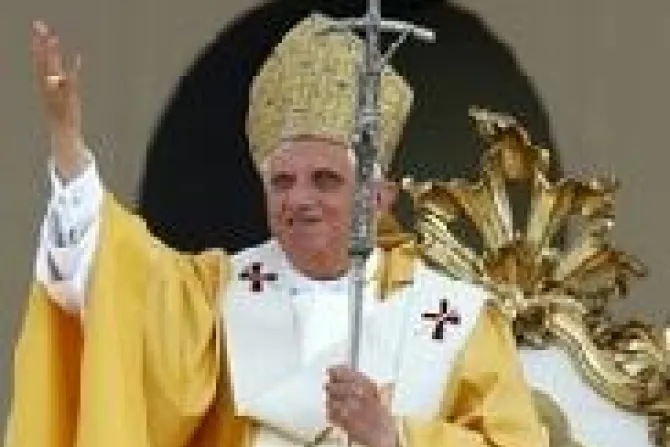Rome, Italy, Apr 23, 2007 / 05:24 am
Enjoying the second day of his pastoral visit Lombardi Dioceses of Vigevano and Pavia, Pope Benedict XVI celebrated Holy Mass at the Borromeo College of Pavia. The Holy Father focused his homily on the conversion of Saint Augustine, whose bodily remains the Holy Father visited at an Augustinian Monastery in the area. The conversion of St. Augustine, Benedict said, was not an event, but a path.
The Holy Father began his homily by examining the work done by the Apostles in the work of preaching conversion in this Sunday’s Gospel. “During Easter time,” His Holiness began, “the Church presents us, Sunday by Sunday, some parts of the preaching with which the Apostles, particularly Peter, invited Israel to faith in Jesus Christ.” Before the Sanhedrin today, Peter “responded with a brief catechesis on the essence of the Christian faith.”
“This brief catechesis,” Benedict continued, “is not valid only for the Sanhedrin. It speaks to all of us.” Jesus is, according to the Pope, “the ‘head’ that leads us on the way and the ‘savior’ that justifies our life.” In fact, he said, the keywords of Peter’s catechesis are “conversion” and “pardon for sin,” “which correspond to Christ’s two titles, ‘head’ and ‘savior.’”
The Pope asked what one needs to do to convert. Noting that “conversion has its own, proper form for each life,” he added that “throughout the history of Christianity, the Lord has sent us models of conversion, so that we may orient ourselves by looking at their example.”
Benedict XVI then noted the moving story of conversion found in Augustine’s Confessions. By reading The Confessions Benedict said, “one can see that the conversion was not an event that happened in a particular moment, but was, instead, a path.”
Moreover, “this path did not end at the Baptismal font.” St. Augustine’s conversion was a gradual process, and “we can, therefore, speak of the ‘conversions’ of Augustine that were one large conversion that took place in his search for the Face of Christ and then while journeying along with Him.”
The Pope continued by expressing his desire to list “the three great steps on this path to conversion.” “The first, fundamental conversion,” he said, “is the interior journey towards Christianity - that is, the desire to want to know Christ.”
“The second conversion is described by St. Augustine at the end of the second book of his Confessions.” After having been baptized, St. Augustine returned to Africa “and there he founded, together with his friends, a small monastery.” However, the second step was his being called “to live with Christ for all. He had to translate his knowledge and sublime thoughts into the language and thinking of the simple people of his city.”
Citing his humility as the “third decisive step on St. Augustine’s path to conversion,” the Pope told those present that Augustine had found “the highest level of humility . . . the humility to recognize that the bountiful mercy of God was continually necessary for himself and the entire pilgrim Church.”
Benedict ended his homily by thanking “God for the great light that shines forth from the wisdom and humility of Saint Augustine.” The Holy Father prayed that “the Lord give all of us, day by day, the necessary conversion and lead us towards true life.”


